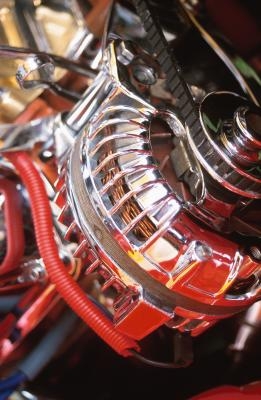
Alternators are designed to charge your car battery and power the electrical devices in your car, but they don't generally produce the correct output voltage at low revolutions per minute (RPMs). This means that if you use electrical equipment in your car while the engine has low RPMs, the battery is powering them. Alternator voltage increases as the rotor's speed increases. You can increase the rotor's speed at low RPMs by putting a smaller pulley wheel on the alternator. A smaller pulley wheel lessens the distance the wheel needs to turn to complete one revolution and makes the rotor turn more quickly, increasing the voltage.
Disconnect the clamp on the end of the black battery cable from the battery terminal before getting your alternator to work at low RPMs. Use a wrench and loosen the nut, then lift off the cable and place it away from the battery terminal.
Loosen the two bolts -- one at the front and one at the rear -- that connect the alternator to the car's engine. Loosen the nut that connects the adjustable bracket on the front of the alternator to the alternator.
Push the alternator toward the car's engine using your hands. This loosens the alternator belt. Lift the alternator belt off the pulley wheel.
Remove the large bolt on the front of the pulley wheel. Using an adjustable wrench, clamp it on the outside of the pulley wheel to stop it from turning. Undo the bolt on the front of the pulley while keeping the wheel from turning. Remove the pulley wheel by pulling it off the alternator rotor shaft.
Measure the diameter of the pulley wheel you just removed using a ruler. Get a smaller pulley wheel from an aftermarket car store. The pulley wheel needs to be about half the diameter of the pulley wheel you just removed as this will rotate quicker, increasing the output voltage from the alternator at low RPMs.
Place a smaller pulley wheel onto the rotor shaft using your hands. Slide it over the shaft and push it into place using your hands. Replace the large bolt by screwing it in place using your fingers. Tighten the bolt by holding the outside of the pulley wheel using an adjustable wrench, and then tighten the bolt using another wrench.
Place the alternator belt over the smaller pulley wheel. Pull the alternator away from the car's engine until the belt tightens. Keep pulling the alternator so the belt remains tight, and tighten the bolt on the adjustable bracket on the front of the alternator using a wrench. Tighten the bolts on the front and rear of the alternator that you loosened earlier using a wrench. Check that the belt is still tight.
Reconnect the clamp on the end of the black battery cable onto the negative terminal of the car battery. The negative terminal is labeled "-." Place the clamp over the battery terminal and tighten the bolt using a wrench. Start your car's engine, and your alternator works at low RPMs.